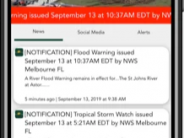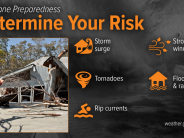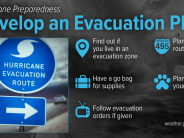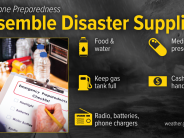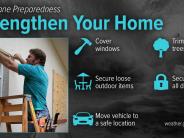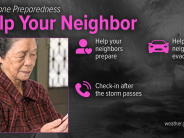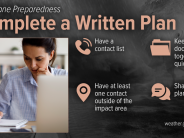Storm Preparation
Storm Preparation
1. Sign up for telephone notifications with the “AlertVolusia" Emergency Notification.
2. Create a Family Preparation Plan
- Have a family meeting to talk about disasters. Children should be encouraged to talk about their fears, and parents should convey the steps they take to keep everyone safe. Together, develop a list of things to take care of in preparation.
- Make an evacuation plan - will your family prepare to shelter in place, or evacuate to a nearby shelter?
- Check your home for vulnerable areas - walk around and evaluate the roof, windows, garage doors, patio doors, screen-enclosed rooms, landscaping, etc., to see what protective measures you need to take if a storm is approaching.
- Make arrangements well in advance of a storm to take care of infants, the elderly, and those with special needs. Persons with special needs should register with the Florida Department of Health in Volusia County.
- Make sure you have a week’s supply of nonperishable food, water, and medical items for your family. Learn more about your Hurricane Survival Kit HERE
3. Be informed! Meteorologists can now predict more accurately days in advance of a hurricane. Watch local news, or visit the National Hurricane Center and the National Weather Service Melbourne to stay on top of potential storms.
4. Make a physical list of all important phone numbers to make contact easily when necessary, including out-of-state contacts.
5. Be financially ready for a hurricane. Once the threat of harm has passed, having your homeowner's or renter's insurance policy, bank account information, and other household records will be very important as you begin the recovery process. The FEMA Emergency Financial First Aid Kit can help you get ready for this moment.
Insurance
Insurance policies should be reviewed well in advance of a storm. Once a hurricane watch has been issued, most insurers will not issue new or additional coverage (this includes flood insurance).
Consider purchasing flood insurance, which is typically NOT covered under a homeowner's insurance policy. Double-check your insurance coverage and keep policies in a safe place. Take pictures of your belongings for claim purposes, and take another picture of the damage to the property after the storm. Consider purchasing a flood insurance policy if you don’t have one. Twenty-five percent of insured flood losses occur outside of a mapped high-risk flood zone. There’s normally a thirty-day waiting period after you purchase a flood insurance policy before it goes into effect, so don’t wait until the storm is a few days out. Remember, your homeowner’s insurance policy DOES NOT cover floods! Visit www.visit floodsmart.gov for more information.
Tips From Public Works:
- If you have them, know how your home's hurricane shutters are installed. There are many types of shutters, from galvanized steel panels to roller shutters to accordion style. If it's been a while since you tried them, or if you're new to your home, it's a good idea to do a practice run on a few windows before the real event. Don’t have hurricane shutters? Consider purchasing them. Remember, “If the wind stays out, the roof stays on.”
- If you have an older garage door, consider adding braces when the storm approaches; 80% of wind entry into homes is through the garage when the door fails.
- Gathering some supplies before a hurricane is bound for land will save you time and frustration in mobbed stores. Make sure you have a store of water, canned food, and hygiene products to last in case water and power are knocked out. Don't forget to keep a can opener handy! Check the batteries in your flashlights and radios.
- If you don’t already have one, buy an NOAA weather radio.
- Ensure you have a one-month supply of any medications you are currently prescribed.
- Keep your car's tank full to avoid long gas station lines at the last minute.
- Limit flying debris outside your home: trim dead wood from trees, check for loose rain gutters and downspouts, and secure lawn furniture.
- Double-check your insurance coverage and keep policies in a safe place. Take pictures of your belongings for claim purposes, and take another picture of the damage to the property after the storm.
For the best information available on hurricane preparedness, visit https://www.ready.gov/hurricanes.

